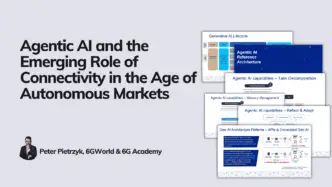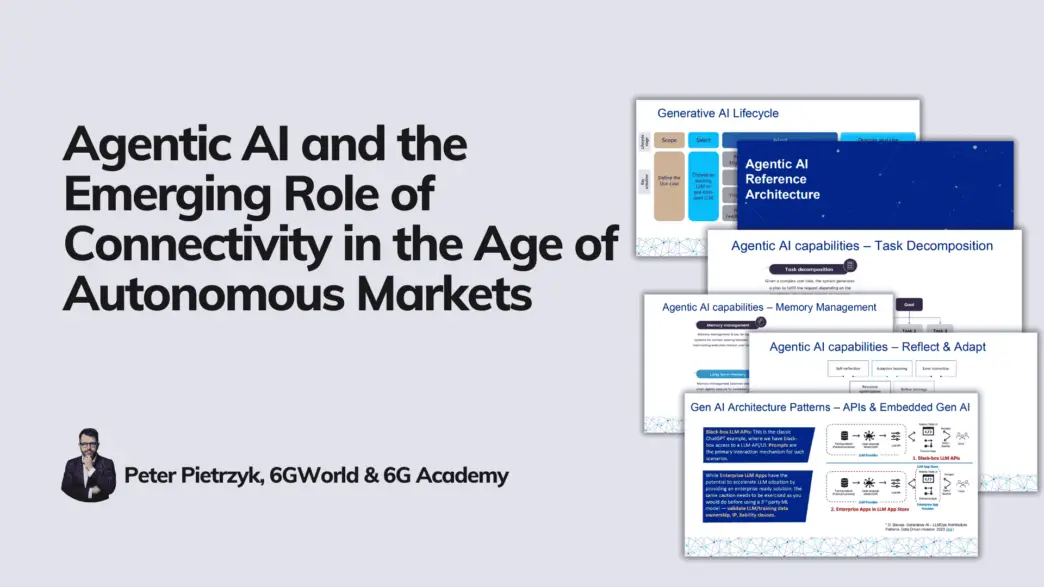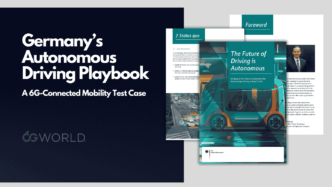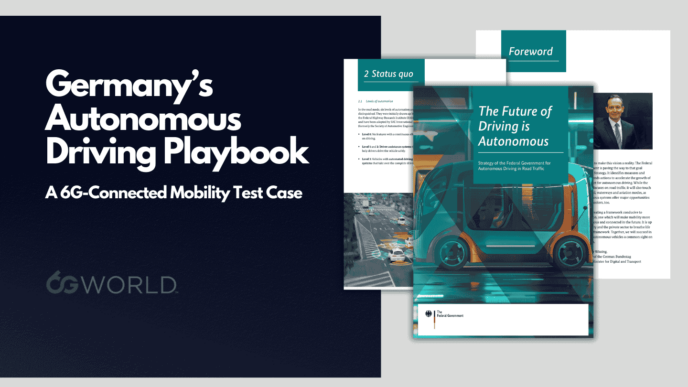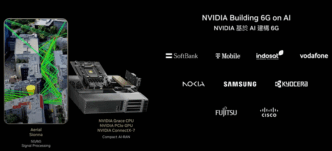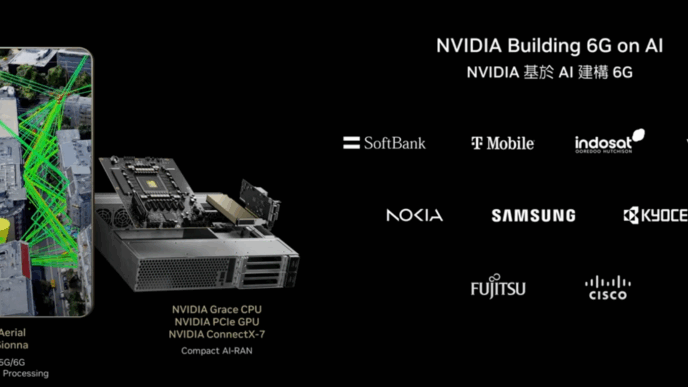The Rise of Agentic AI
Artificial intelligence is shifting paradigms. We’re no longer just building tools that assist humans — we’re beginning to design agents that act on their behalf. Known as Agentic AI, this evolution involves autonomous, proactive, and adaptive software entities capable of complex tasks: planning a trip, negotiating contracts, making purchases — even interacting with other agents to compose workflows.
But here’s the twist: the full potential of Agentic AI won’t be unlocked by software alone.
It demands a new substrate of connectivity — agile, programmable, context-aware — to support distributed cognition at scale. In other words, 6G infrastructure will be essential to enabling the next wave of AI-driven interaction.
Agentic Marketplaces: From App Stores to Intelligence Ecosystems
One of the most compelling directions discussed in “A Comprehensive Guide to Agentic AI“ by Dr. Debmalya Biswas is the concept of an Agent Marketplace — a new kind of digital exchange where autonomous agents are published, discovered, composed, and transacted with, based on natural language queries or goal-based constraints.
Rather than browsing for “apps”, users — or their digital counterparts — will seek out capability-based agents:
- A “connectivity optimizer” agent for edge orchestration
- A “policy translator” agent to map local regulatory frameworks
- An “autonomous network architect” agent that composes NFV functions dynamically
These marketplaces will enable dynamic agent composition based on tasks, user personas, or environmental context — much like microservices, but with cognition and memory.
Where Connectivity Fits In
To function seamlessly, these agentic systems must:
- Discover and interact with distributed data sources
- Operate across heterogeneous infrastructure (cloud, edge, device)
- Handle privacy, latency, and bandwidth constraints in real time
This is where connectivity is no longer a passive pipe, but a dynamic partner in execution. Consider these applications:
- Dynamic Spectrum Access: Agents negotiate short-term spectrum leases across bands based on real-time needs.
- Edge-Driven Intelligence: Agents are deployed closer to sensors or endpoints, with compute decisions driven by latency and energy parameters.
- Context-Aware Routing: Based on user behavior, network congestion, or application SLAs, agents proactively shift routing strategies.
Agentic AI demands connectivity that can reason — or at the very least, provide real-time observability, intent-based APIs, and composable control surfaces.
Advantages — and Unresolved Frictions
Opportunities:
- Massive Automation: Agent-based service composition could reduce deployment times for enterprise connectivity or smart city platforms by orders of magnitude.
- Personalized Services at Scale: From user-specific network slices to individualized content moderation, agents can adapt to users in real time.
- Network as a Market Actor: In future scenarios, a connectivity agent could bid in data marketplaces, optimize routes, or orchestrate services based on dynamic KPIs.
Challenges:
- Non-Determinism: Agentic systems may not produce the same results twice. This raises concerns for safety, traceability, and compliance.
- Standardization Gaps: Without common agent registries, schemas, or performance benchmarks, marketplaces will remain fragmented.
- Trust & Security: Memory management, hallucination control, and explainability are still nascent in most agent architectures.
What Needs to Happen Next
To make Agentic AI + 6G a reality, the ecosystem must:
- Define Agent Interoperability Standards
Just as 5G relied on 3GPP, Agentic AI needs protocols to define agent roles, capabilities, and trust frameworks. - Bridge LLMs with Real-Time Infrastructure
LLMs are powerful, but brittle. Integration with telemetry, vector DBs, and low-latency control loops is critical for real-world decision-making. - Enable “Cognitive Connectivity” APIs
Network functions must expose intent-based APIs to agents — whether for QoS, policy negotiation, or resource allocation. - Design with Privacy and Observability in Mind
With agents acting independently, auditability, stateful memory, and responsible AI practices are paramount.
Final Thought: Is This the “App Store Moment” for Connectivity?
If cloud computing gave rise to the app store economy, Agentic AI might catalyze the intelligence economy — where enterprises, devices, and users transact in real-time with distributed cognition.
But this won’t happen in a vacuum. It requires a new network architecture, agent-aware protocols, and a rethinking of trust and control.
In that sense, 6G may not just be the infrastructure for ubiquitous connectivity — but the nervous system for a world where intelligence itself is composable, autonomous, and ambient.
Are we ready?
For more thought leadership on the intersection of AI, connectivity, and network evolution, stay tuned to 6GWorld.com.
